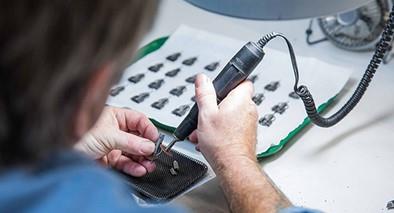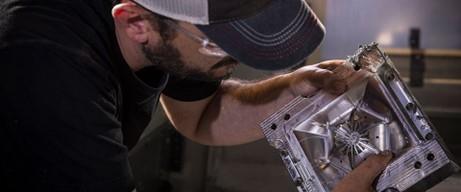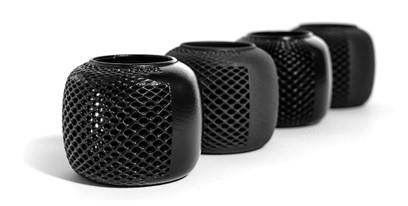Injection moulding continues as the workhorse that produces parts globally, without much fanfare. Perfected over decades, moulding remains the go-to service for cost-effective parts at quantities from 50 to over a million.
A future where 3D printing replaces injection moulding may be far off, but today the two work beautifully in tandem. While 3D printing is often touted as a go-to service for prototyping, costs are typically prohibitive when scaling up to production volumes, which is where injection moulding can come in.
Deciding which service is the right route for you? Let’s start with a look at cost drivers with both manufacturing services.
Post processing work
Build time and post-processing are two main cost drivers. Determining ways to streamline your design or do without unnecessary finishes cuts down significantly on expenses.

3D Printing
Build time: Far and away the most significant cost driver for 3D printing, a longer build time means a more expensive part. Take a solid cube, for example. While a simple part, printing the condensed cube layer by layer would take more time than if the cube’s interior used a cross-linked design, which requires less material and subsequently less machine time. Any necessary support structures during the printing process also increases machine time and cost.
Material cost: Depending on the technology, 3D printing materials can add expense. While direct metal laser sintering (DMLS) recycles all unused powder, a process like selective laser sintering (SLS) uses a powder-based polymer process that does not allow for recycling, driving up cost.
Post-processing: Required with nearly all 3D-printed parts, these processes strengthen parts, improve cosmetic appearance and more, but also require manual work that can be time consuming. Each 3D printing service also comes with necessary post-processing, so researching what is required on the front end will help determine cost.
Injection Moulding
Part complexity: Several design factors can lead to a more complex part with injection moulding. Design for manufacturability (DFM) analysis is critical to identify modifications that reduce cost. For example, a small part doesn’t automatically translate to a smaller mould size. If your part design requires an undercut or side action, mould base size (and cost) increases significantly. If a cam or insert is required, your overall mould size can increase by £1,000-£2,000 per component.
Design Time
For engineers under increasing pressure to bring products to market, time is money. Quick iteration is key to shorten the timeline to perfect your design and move from concept to final part. That’s why we see our customers start with 3D printing during the prototyping process before moving to injection moulding once a part is ready for production volumes.
Product iteration with 3D printing is faster and less expensive compared to injection moulding. If you identify a design flaw once a part is 3D printed, the CAD file can be easily tweaked and uploaded with another iteration printed and sent your way in days. Injection moulding requires significant expense with each design change due to the reworking of the mould. Furthermore, injection moulding usually requires more upfront design work since creating a mould can be a complex process with many factors to consider.

Set Up and Tooling
Set up and tooling costs are another area where 3D printing is the clear winner, as it does not require investment in either. Injection moulding on the other hand comes with tooling costs and often a set-up fee with each run of moulded parts. As we discussed earlier, DFM analysis will help reduce tooling costs, but a mould may still bring thousands in up-front expense.
Piece-Part Price
Now here’s an opportunity for injection moulding to shine. Piece-part price for injection moulding is going to be significantly lower compared to 3D printing once we reach a high volume of parts. While we have discussed the cost of tooling at length, each part that comes off that mould will be more cost-effective once you reach quantities that rationalise the initial investment.
Fortunately, our applications engineers are well-versed in helping our customers determine if piece-part price cost savings justify the initial upfront costs of injection moulding.

Post-processing
Regardless of technology, nearly all 3D-printed parts will require some level of post-processing. Mandatory processes after a part is printed include removing support structures or excess resin, depending on the technology you choose. The emergence of post-processing options, such as vapour smoothing, improving strength and aesthetics have been critical in expanding the applications of additive manufacturing, but each comes with an additional expense.
Injection moulding on the other hand comes with more than 100 thermoplastic and thermoset materials that eject from the mould with high-quality finishes fit for production. Finishing process are available to texture a mould, add threaded inserts, laser engraving and more, but aren’t necessary for the durability and finish of the part.
Prototyping vs. On-Demand Manufacturing
Injection moulding is still a viable option at the prototyping stage. When prototyping at Protolabs, we use a single-cavity aluminium mould that can produce hundreds of parts and can be typically delivered in a week or less. Our customers often choose prototyping with injection moulding if they need to complete design or material iterations, as well as assess cost or manufacturability trade-offs.
Once past the prototyping stage, our customers often move to on-demand manufacturing, producing injection moulded parts at Protolabs speeds. Using a steel mould, part quantities are virtually unlimited. On-demand injection moulding with us allows you to meet inventory needs with no minimum order quantities, and offers supply chain flexibility through bridge tooling, just-in-time production, or dual-sourcing strategies.
